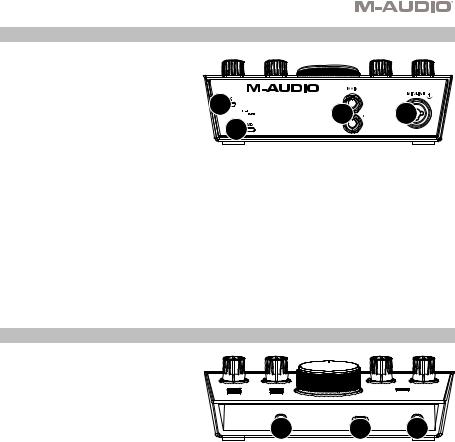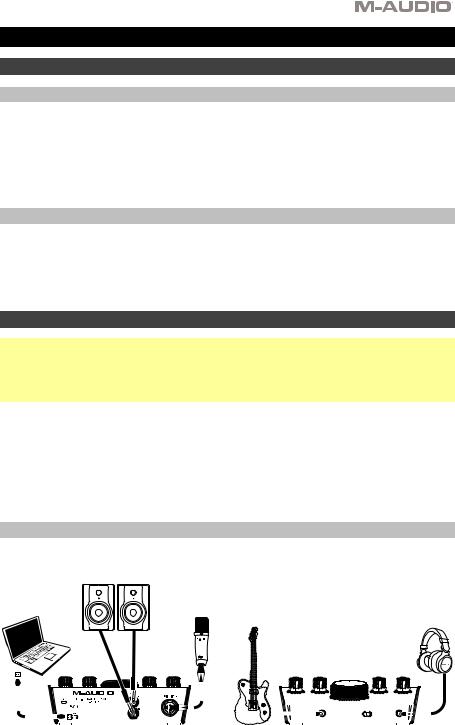M-Audio M-Track 2x2 Vocal Studio Pro User manual

User Guide
English ( 3 – 8 )
Guía del usuario
Español ( 9 – 14 )
Guide d’utilisation
Français ( 15 – 20 )
Guida per l’uso
Italiano ( 21 – 26 )
Benutzerhandbuch
Deutsch ( 27 – 32 )
Appendix
English ( 33 – 34 )

2

User Guide (English)
Introduction
Box Contents
M-Track 2X2 |
Microphone Windscreen |
Software Download Cards |
NOVA Black Microphone |
HDH40 Headphones |
User Guide |
XLR Microphone Cable |
USB-C–to–USB-C Cable |
Safety & Warranty Manual |
Microphone Shock Mount |
USB-C–to–USB-A Cable |
|
Support
Register your product at m-audio.com and log into your account to download the latest software and any necessary drivers for your product.
You can view and download the latest documentation, system requirements, and other information on the website.
For additional product support, visit m-audio.com/support.
Setup
Windows users: Before connecting M-Track 2X2 to your computer, install the drivers:
1.Go to m-audio.com/drivers and download the latest M-Track 2X2 driver for your operating system.
2.Open the file you downloaded and double-click the driver installer file.
3.Follow the on-screen instructions to install the drivers.
Note:
•Remember to select M-Track 2X2 as your interface in the Preferences, Options, Device Setup, etc. in your digital audio workstation (DAW).
•Use the +48V (Phantom Power) Switch only if a microphone requires phantom power. Most dynamic microphones and ribbon microphones do not require phantom power, but most condenser microphones do. Consult your microphone's documentation to find out whether it needs phantom power. When using the included NOVA Black microphone, turn the +48V (Phantom Power) Switch on.
Connection Diagram
Items not listed under Introduction > Box Contents are sold separately.
Powered Monitors
Computer |
Microphone |
|
Guitar
Headphones
|
|
|
|
|
|
|
|
|
|
|
|
|
|
|
|
|
|
|
|
|
|
|
|
|
|
|
|
|
|
|
|
|
|
|
|
|
|
|
|
|
|
|
|
|
|
|
|
|
|
|
|
|
|
|
|
|
|
|
|
|
|
|
|
|
|
|
|
|
|
|
|
|
|
|
|
|
|
|
|
|
|
|
|
|
|
|
|
|
|
|
|
|
|
|
|
|
|
|
|
|
|
|
|
|
|
|
|
|
|
|
|
|
|
|
|
|
|
|
|
|
|
|
|
|
|
|
|
|
|
|
|
|
|
|
|
|
|
|
|
|
|
|
|
|
|
|
|
|
|
|
|
|
|
|
|
|
|
|
|
|
|
|
|
|
|
|
|
|
|
|
|
|
|
|
|
|
|
|
|
|
|
|
|
|
|
|
|
|
|
|
|
|
|
|
|
|
|
|
|
|
|
|
|
|
|
|
|
|
|
|
|
|
|
|
|
|
|
|
|
|
|
|
|
|
|
|
|
|
|
|
|
|
|
|
|
|
|
|
|
|
|
|
|
|
|
|
|
|
|
|
|
|
|
|
|
|
|
|
|
|
|
|
|
|
|
|
|
|
|
|
|
|
|
|
|
|
|
|
|
|
|
|
|
|
|
|
|
|
|
|
|
|
|
|
|
|
|
|
|
|
|
|
|
|
|
|
|
|
|
|
|
|
|
|
|
|
|
|
|
|
|
|
|
|
|
|
|
|
|
|
|
|
|
|
|
|
|
|
|
|
|
|
|
|
|
|
|
|
|
|
|
|
|
|
|
|
|
|
|
|
|
|
|
|
|
|
|
|
|
|
|
|
|
|
|
|
|
|
|
|
|
|
|
|
|
|
|
|
|
|
|
|
|
Rear Panel |
|
|
|
|
|
|
|
|
|
|
|
|
|
|
|
|
|
|
|
|
Front Panel |
|
|
|
|
|
||||||||||||||||||||
3

Audio Setup
Windows users: Before connecting M-Track 2X2 to your computer, install the driver:
1.Go to m-audio.com/drivers and download the latest M-Track 2X2 driver for your operating system.
2.Open the file you downloaded and double-click the driver installer file.
3.Read the End-User License Agreement, then check the box to Agree and click Next to continue.
4.Click Install to begin the installation. You may be asked to connect M-Track 2X2 to your computer during the installation process. Click Install on any further system messages during the installation.
5.Once the installation is complete, click Finish.
To use the Windows driver, open the M-Audio M-Track 2X2 Control Panel. Here, you can set your Preferred Buffer Size and Sample Rate.
To set M-Track 2X2 as your default playback device, follow the directions below based on your computer’s operating system.
Windows:
1.Use the included USB cable to connect the M-Track 2X2 to your computer.
2.In the Taskbar, locate the Volume Control "speaker" icon. Right-click the speaker and select Playback Devices.
Alternatively, go to Start Menu > Control Panel (or Settings > Control Panel in Classic View) > Hardware and Sound > Sound.
3.In the Windows Sound control panel select the Playback tab and select M-Track 2X2 as the default device.
4.Click the Recording tab and select M-Track 2X2 as the default device.
5.Click Properties in the lower right-hand corner.
6.In the new window, click the Advanced tab and select 2-channel, 24-bit, 48000 Hz (Studio Quality) as the default format.
7.Uncheck both boxes under Exclusive Mode.
8.Click OK to close the Properties window.
9.Click OK to close the Sound control panel.
4

Mac OS X:
1.Use the included USB cable to connect the M-Track 2X2 to your computer.
2.Go to Applications > Utilities > Audio MIDI Setup.
3.In the Audio Devices window, select M-Track 2X2 in the left column.
4.Right-click M-Track 2X2, and select Use this device for sound input.
5.Right-click M-Track 2X2, and select Use this device for sound output.
6.Quit Audio MIDI Setup.
Setting Up M-Track 2X2 with Your Software
Be sure your audio software program is set up to receive audio from the M-Track 2X2. This can usually be done in your software's Preferences, Device Setup, or Options. Please consult your software manual for more information.
To set up the M-Track 2X2 with Cubase LE:
1.Use the included USB cable to connect the M-Track 2X2 to your computer.
2.Open Cubase LE.
3.Go to Devices > Device Setup, and click VST Audio System in the left side of the window.
4.Open the dropdown menu at the top and select M-Audio M-Track 2X2 ASIO. Click Switch to confirm.
Note: For Mac users, select M-Audio M-Track 2X2.
5.Click OK to close the Device Setup window.
You can now add audio tracks to receive audio from sources connected to the M-Track 2X2 inputs and stream recorded audio back through the M-Track 2X2 outputs.
5

Features
Top Panel
1.Input Gain: Adjusts the input's gain level. Set this knob so the
corresponding LED Meter (located below the knob) displays a "healthy" (-3 dB, yellow LED) level during performance—but not so high that the meter "clips" or peaks (Clip, red LED), causing distortion in the audio.
2.LED Meters: Indicates the input signal level from the Combo Input or
Instrument Input.
3.USB / Direct Blend: Adjusts the mix of the audio signal from your inputs (Direct) and the audio output of your computer (USB) that will be sent to the Main Outputs and Headphone Output.
INPUT |
INPUT |
|
3 |
4 |
|
1 |
1 |
|
|||
|
|
|
|
||
2 |
2 |
5 |
7 |
+48V |
6 |
|
|
|
|
|
|
M-TRACK 2X2
C -SERIES
+48V
This knob is useful for dealing with “latency” when you are recording in your DAW. Latency is a delay in sound that may occur between the incoming sound (playing your instrument, singing, etc.) and outgoing sound (when you hear it in the DAW).
Latency is often the result of the “buffer size” setting, which is usually located in your DAW’s Preferences, Options, or Device Setup menu. Higher buffer sizes generally result in higher latency. In some cases, lower buffer size settings can consume a lot of your computer’s CPU and cause audio glitches. To prevent these audio glitches, you will need to use a higher buffer setting, and this may result in latency.
If you are experiencing latency when recording, adjust the knob towards the Direct position to increase the blend of unprocessed audio from your inputs directly to your Main Outputs and Headphone Output. This will let you hear the incoming audio from your inputs without latency while still being able to hear the audio from your DAW. When listening to the playback, adjust the knob all the way to the USB position.
If your computer is powerful enough, you may be able to set the buffer size setting in your DAW low enough such that you may never need to listen to the direct audio signal from your inputs. In this case, set the USB / Direct Blend knob all the way to the USB position to monitor only the audio output of your DAW.
4.Headphone Level: Adjusts the output volume of the Headphone Output.
5.Monitor Level: Adjusts the output volume of Main Outputs, which should be connected to your powered monitors or amplifier system.
6.Power LED: Lights up when a valid USB connection has been established between your computer and M-Track 2X2. Use this light to verify that M-Track 2X2 is receiving power and is ready to use.
7.+48V (Phantom Power) LED: Lights up when phantom power is engaged.
6

Rear Panel
1.USB Port (Type C): This connection will allow you to send audio and MIDI data to and from a computer. Use the included USB-C-to-USB-C or USB-C-to-USB-A cables to connect the M-Track 2X2 to a computer. The M-Track 2X2 requires a USB 2.0 connection (or higher).
4 |
M-TRACK |
2X2 |
3 |
2 |
|
C -SERIES |
|
||
|
1 |
|
|
|
2.Combo Input: Connect a microphone, a guitar or bass with an active pickup, or a linelevel device to this input. For microphones, use an XLR or 1/4” (6.35 mm) TRS cable. For a guitar or bass with an active pickup, use a standard 1/4” (6.35 mm) TS cable. For line-level signals, use a 1/4" (6.35 mm) TRS cable. View the input signal level with the LED Meters.
3.Main Outputs: Use standard 1/4" (6.35 mm) TRS cables to connect these outputs to your powered monitors, amplifier system, etc. The mix you hear from these outputs will be determined by the USB / Direct Blend knob. The level of these outputs is controlled by the Monitor Level knob.
4.Kensington Lock Slot: You can use this Kensington lock slot to secure M-Track 2X2 to a table or other surface.
Front Panel
1. Headphone Output: Connect 1/4" |
|
|
|
(6.35 mm) TRS headphones to this |
|
|
|
output. The mix you hear from this |
|
|
|
output will be determined by the |
|
|
|
USB / Direct Blend knob. The level |
2 |
3 |
1 |
of this output is controlled by the |
|||
Headphone Level knob. |
2.Instrument Input: Connect a guitar with a passive pickup or other high-impedance signal to this input with a 1/4" (6.35 mm) TS cable. View the input signal level with the LED Meters.
3.+48V (Phantom Power) Switch: This switch activates and deactivates phantom power. When activated (lit), phantom power supplies +48 volts to the Combo Input. Please note that most dynamic microphones and ribbon microphones do not require phantom power, while most condenser microphones do. Consult your microphone's documentation to find out whether it needs phantom power. The included NOVA Black microphone requires phantom power.
7

NOVA Black Microphone Usage
Connections and Phantom Power
The NOVA Black microphone outputs a balanced, low-impedance signal. It is designed to be connected to the mic-level inputs of a mixer channel or a dedicated high-quality preamp.
As with all condenser microphones, your NOVA Black microphone requires power in order to operate. You will need to connect the NOVA Black microphone to the XLR connection of a preamp or mixer channel strip that supplies +48V phantom power (phantom power shares the same XLR cable as the audio from the microphone).
To avoid pops and surges that can damage components like speakers and microphones, always follow these steps when connecting the mic and/or cable:
1.Turn the gain of the channel on your preamp/mixer all the way down.
2.If your preamp's/mixer's phantom power is activated, deactivate it.
3.Use a high-quality XLR cable (included) to connect the NOVA Black microphone to that channel on your preamp/mixer.
4.Activate your preamp's/mixer's phantom power.
5.Turn up the gain of the channel on your preamp/mixer.
Before disconnecting the mic and/or cable, repeat Steps 1 and 2.
Cardioid Pattern
Cardioid is the most universal microphone polar pattern. This is because the back of the microphone rejects sound, allowing the engineer to isolate the signal source from other performance elements or background noise. The logo side of the microphone is the "live" side.
Care of Your Microphone
•Never subject the NOVA Black microphone to physical shock.
•Always use a mic stand and use the included shock mount when securing it to a stand. Push the metal clips on the sides of the shock mount toward each other to open the center opening and then slide the bottom of the NOVA Black microphone into and through the center of the shock mount. Release the clips so the center of the shock mount holds the NOVA Black microphone in place.
•Always wipe the NOVA Black microphone's exterior with a soft dry cloth and return it to its case after each use to prevent damage caused by dust.
•If your NOVA Black microphone needs more extensive cleaning, lightly dampen a soft cloth with water or mild household soap and clean the metal exterior, wiping it completely dry when finished. Never spray a cleaning agent on the NOVA Black microphone itself, as excessive moisture can damage the unit.
•Avoid subjecting the NOVA Black microphone to any kind of moisture. In vocal applications, use a windscreen to protect the diaphragm from the build-up of breath condensation and saliva.
•Never disassemble the NOVA Black microphone. There are no user-serviceable parts inside.
•Use high-quality cables to avoid short circuits that may damage the microphone's electronics.
•Avoid temperature extremes above 95° F / 35° C and below 50° F / 10° C. To avoid harmful condensation on the diaphragm when moving between indoor and outdoor environments, allow the NOVA Black microphone to acclimate to room (air) temperature before connection.
8

Guía del usuario (Español)
Introducción
Contenido de la caja
M-Track 2X2 |
Cable USB-C-a-USB-C |
Micrófono NOVA Black |
Cable USB-C-a-USB-A |
Cable de micrófono XLR |
Tarjetas de descarga de software |
Montaje a prueba de golpes para micrófono |
Guía del usuario |
Paraviento para micrófono |
Manual sobre la seguridad y garantía |
Auriculares HDH40 |
|
Soporte
Registre su producto en m-audio.com e inicie sesión en su cuenta para descargar el software más reciente y todos los controladores necesarios para su producto.
Es posible ver y descargar la documentación más reciente, los requisitos del sistema y demás información existente en el sitio web.
Para obtener soporte adicional del producto, visite m-audio.com/support.
Instalación
Usuarios de Windows: Antes de conectar el M-Track 2X2 a su computadora, instale los drivers:
1.Vaya a m-audio.com/drivers y descargue el driver M-Track 2X2 más reciente para su sistema operativo.
2.Abra el archivo que descargó y haga doble clic en el archivo instalador del driver.
3.Siga las instrucciones de la pantalla para instalar los drivers.
Nota:
•Recuerde seleccionar M-Track 2X2 como su interfaz en las Preferences (Preferencias), Options (Opciones), Device Setup (Configuración de dispositivo), etc. de su estación de audio digital (DAW).
•Utilice el interruptor +48V (potencia fantasma) solamente si un micrófono requiere potencia fantasma. Más dinámicos y de cinta micrófonos no requieren alimentación fantasma, mientras que la mayoría de los micrófonos de condensador la requieren. Consulte la documentación de su micrófono para averiguar si necesita alimentación fantasma. Cuando utilice el micrófono NOVA Black incluido, conecte el interruptor de +48 V (alimentación fantasma).
Diagramas de conexión
Los elementos que no se enumeran en Introducción > Contenido de la caja se venden por separado. Monitores alimentados
Computadora
Micrófono
Guitarra
Auriculares
|
|
|
|
|
|
|
|
|
|
|
|
|
|
|
|
|
|
|
|
|
|
|
|
|
|
|
|
|
|
|
|
|
|
|
|
|
|
|
|
|
|
|
|
|
|
|
|
|
|
|
|
|
|
|
|
|
|
|
|
|
|
|
|
|
|
|
|
|
|
|
|
|
|
|
|
|
|
|
|
|
|
|
|
|
|
|
|
|
|
|
|
|
|
|
|
|
|
|
|
|
|
|
|
|
|
|
|
|
|
|
|
|
|
|
|
|
|
|
|
|
|
|
|
|
|
|
|
|
|
|
|
|
|
|
|
|
|
|
|
|
|
|
|
|
|
|
|
|
|
|
|
|
|
|
|
|
|
|
|
|
|
|
|
|
|
|
|
|
|
|
|
|
|
|
|
|
|
|
|
|
|
|
|
|
|
|
|
|
|
|
|
|
|
|
|
|
|
|
|
|
|
|
|
|
|
|
|
|
|
|
|
|
|
|
|
|
|
|
|
|
|
|
|
|
|
|
|
|
|
|
|
|
|
|
|
|
|
|
|
|
|
|
|
|
|
|
|
|
|
|
|
|
|
|
|
|
|
|
|
|
|
|
|
|
|
|
|
|
|
|
|
|
|
|
|
|
|
|
|
|
|
|
|
|
|
|
|
|
|
|
|
|
|
|
|
|
|
|
|
|
|
|
|
|
|
|
|
|
|
|
|
|
|
|
|
|
|
|
|
|
|
|
|
|
|
|
|
|
|
|
|
|
|
|
|
|
|
|
|
|
|
|
|
|
|
|
|
|
|
|
|
|
|
|
|
|
|
|
|
|
|
|
|
|
|
|
|
|
|
|
|
|
|
|
|
|
|
Panel trasero |
|
|
|
|
|
|
|
|
|
|
|
|
|
|
|
|
|
|
|
|
Panel frontal |
|
|
|
|
|
||||||||||||||||||||||
9

Ajuste del audio
Usuarios de Windows: Antes de conectar el M-Track 2X2 a su ordenador, instale el controlador:
1.Vaya a m-audio.com/drivers y descargue el controlador M-Track 2X2 más reciente correspondiente a su sistema operativo.
2.Abra el archivo y haga doble clic en el archivo instalador del controlador.
3.Lea el Acuerdo de licencia de usuario final, marque la casilla de Agree (Acepto) y haga clic en Next (Siguiente) para continuar.
4.Haga clic en Install (Instalar) para comenzar la instalación. Es posible el sistema le solicite conectar el M-Track 2X2 a su ordenador durante el proceso de instalación. Haga clic en Install en respuesta a todos los posibles mensajes adicionales del sistema durante la instalación.
5.Una vez terminada la instalación, haga clic en Finish (Terminar).
Para utilizar el controlador de Windows, abra el M-Audio M-Track 2X2 Control Panel. Aquí puede configurar su Preferred Buffer Size (Tamaño de búfer preferido) y la Sample Rate (Frecuencia de muestreo).
Para configurar el M-Track 2X2 como dispositivo de reproducción predeterminado, siga las indicaciones que se incluyen a continuación sobre la base del sistema operativo de su ordenador.
Windows:
1.Utilice el cable USB incluido para conectar el M-Track 2X2 a su ordenador.
2.Localice en la barra de tareas el icono del "altavoz" del control de volumen. Haga clic derecho en el altavoz y seleccione Playback Devices (Dispositivos de reproducción).
Como alternativa, haga clic en Start Menu (menú Inicio) > Control Panel (Panel de control) (o Settings [Ajustes] > Control Panel en la Vista clásica) > Hardware and Sound (Hardware y sonido) > Sound (Sonido).
3.En el panel de control Windows Sound (Sonido de Windows), seleccione la pestaña Playback (Reproducción) y seleccione M-Track 2X2 como dispositivo predeterminado.
4.Haga clic en la pestaña Recording (Grabación) y seleccione M-Track 2X2 como dispositivo predeterminado.
5.Haga clic en Properties (Propiedades) en la esquina inferior derecha.
6.En la nueva ventana, haga clic en la pestaña Advanced (Avanzadas) y seleccione 2- channel, 24-bit, 48000 Hz (Studio Quality) (2 canales, 24 bits, 48000 Hz, calidad de estudio) como formato predeterminado.
7.Deshaga la selección de las dos casillas que están bajo Exclusive Mode (Modo exclusivo).
8.Haga clic en OK (Aceptar) para cerrar la ventana de propiedades.
9.Haga clic en OK (Aceptar) para cerrar el panel de control de sonido.
10

Mac OS X:
1.Utilice el cable USB incluido para conectar el M-Track 2X2 a su ordenador.
2.Vaya a Applications > Utilities > Audio MIDI Setup (Aplicaciones > Utilidades > Configuración MIDI de audio).
3.En la ventana Audio Devices (Dispositivos de audio), seleccione M-Track 2X2 en la columna izquierda.
4.Haga clic derecho en M-Track 2X2 y seleccione Use this device for sound input (Utilizar este dispositivo para la entrada de sonido)
5.Haga clic derecho en M-Track 2X2 y seleccione Use this device for sound output
(Utilizar este dispositivo para la salida de sonido)
6.Salga de la configuración MIDI de audio.
Configuración del M-Track 2X2 con su software
Asegúrese de que su programa de software de audio esté configurado para recibir audio desde el M-Track 2X2. Esto puede hacerse habitualmente en Preferences (Preferencias), Device Setup (Configuración de dispositivos) u Options (Opciones). Para más información, consulte el manual de su software.
Para configurar el M-Track 2X2 con Cubase LE:
1.Utilice el cable USB incluido para conectar el M-Track 2X2 a su ordenador.
2.Abra Cubase LE.
3.Vaya a Devices > Device Setup, y haga clic en VST Audio System (Sistema de audio VST) en la parte izquierda de la ventana.
4.Abra el menú desplegable de la parte superior y seleccione M-Audio M-Track 2X2 ASIO. Haga clic en Switch (Conmutar) para confirmar.
Nota: Los usuarios de Mac deben seleccionar M-Audio M-Track 2X2.
5.Haga clic en OK (Aceptar) para cerrar la ventana de configuración de dispositivos).
Puede agregar ahora pistas de audio para recibir audio desde fuentes conectadas a las entradas del M-Track 2X2 y transmitir audio grabado a través de las salidas del M-Track 2X2.
11
